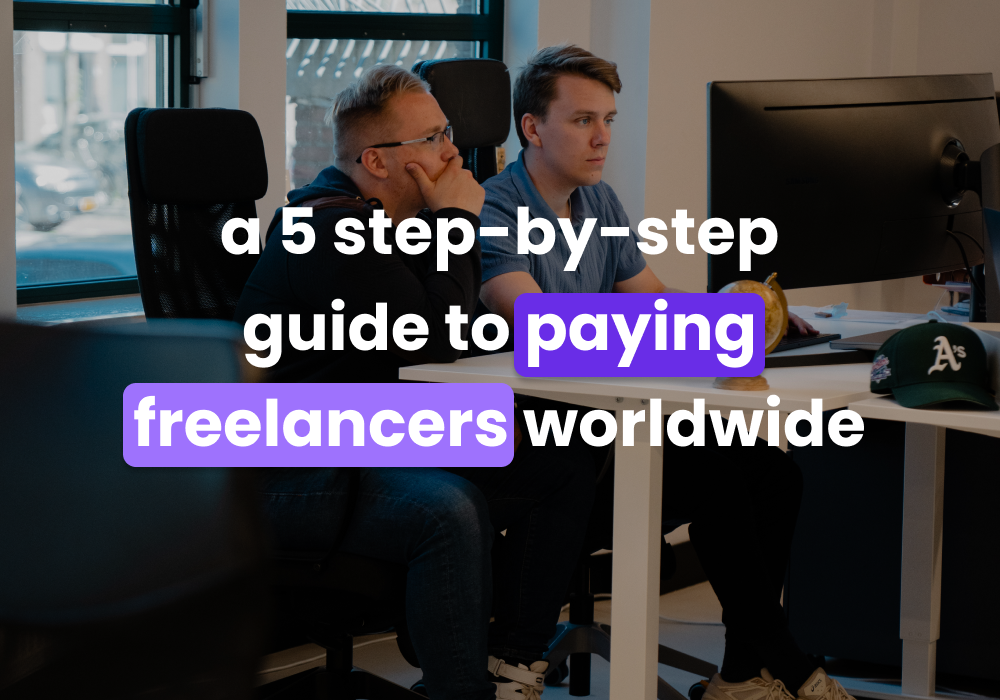The modern labor market is steering more and more towards the gig economy. Now that so many businesses see the benefits of flexible, remote work, freelancing is on the rise like never before. In fact, over half of the US’s labor force is predicted to be freelancing in just six years.
There's much demand for on-demand workers. In fact, 70% of small businesses already use freelancers to quickly fill skill gaps, widen their talent pool, and utilize expertise for niche projects.
However, certain challenges follow as the world learns to adapt to this new paradigm. For instance, paying freelancers isn't the same as paying traditional employees. Not least because freelancers require different tax forms, and there are various ways for freelancers to set their rates - for example, hourly, per-project, or retainer basis.
More complex still is deciphering how to pay freelancers overseas. With that said, in this article, we’ll take you through a few best practices to ensure your freelance pay-out process is as smooth as possible.
Let's dive in!
How Do Freelancers Differ From Traditional Employees?
Before we delve into the nitty-gritty of this blog post, let’s establish why paying freelancers differs from your average employee registered on your payroll.
For starters, freelancers are self-employed. They run their own businesses and, as such, don’t commit long-term to any one employer. Typically, they work remotely but can also hop from location to location. As a result, they're a flexible source of talent for various business types.
Freelancers decide when and where they work and also set their own rates. So this means businesses can’t simply dictate their payment terms as easily. In addition, each new project may vary due to different requirements, workloads, etc., and therefore may demand a different payment schedule.
for the US readers: freelancers are classified as 1099 independent contractors, meaning they pay their own taxes, benefits, and insurance. Freelancers overseas, while classified as 1099 independent contractors, might not require you to fill out the tax form at all. Compare all this to a traditional employee who needs to fill out a W-9 form instead, and for whom you pay benefits and take taxes out of their salary, freelancers seem like the easier option.
At this point, it's worth noting that there are other legal differences between freelancers and contractors. For instance, a contractor may be paid as a W-2 worker just like employees. Contractors are often outsourced to clients by a base company, which may deliver benefits and insurance. As a result, sometimes contractors aren't as independent as freelancers.
How to Pay Freelancers Overseas in 5 Steps
When working with an independent freelancer overseas, here are five steps to help ensure you pay them correctly.
1. Agree on Payment Terms and Legal Jurisdiction
Before fees are due, you and your freelancer should communicate expectations surrounding payment. Most freelancers have set rates and a preferred way to get paid. For example, they might like to be paid hourly, per project, or per specific criteria such as word count. As such, it's imperative you clarify how you'll compensate your freelancers and define clear payment milestones. This goes a long way to avoiding any awkwardness or unnecessary tension later down the line.
Next, discuss which currency payment will be made in. For example, some freelancers overseas already have accounts that can receive USD. However, others will be subject to exchange fees, so you'll need to discuss who's liable for those charges.
Your chosen payment method can also impact the cost of the transfer. So, deciding on a transfer method early is a good idea.
Putting these details into writing is an excellent way to avoid misunderstandings, as is defining the legal jurisdiction to which both parties will answer. A jurisdiction clause ensures only the chosen country’s courts can handle the case, which means their law will be in effect. Therefore, in most cases, it's much easier for your business to handle legal disputes in your own country.
Once you've decided on payment terms and jurisdictions, present everything in writing. This can be done either through a contract or a master service agreement. At this point, you’ll have gone a long way to future-proofing against possible misapprehensions and are better positioned to onboard your freelancer.
To make this process even easier, a freelance management system can automatically generate a smart contract. These kinds of dynamic contracts automatically include the agreed payment details and project description.
2. Tax Compliance
You'll also need to consider taxes when hiring freelancers overseas. Usually, you don’t need to pay, withhold, or report taxes for freelancers that don’t reside in your country. However, you’ll need to swot up on the tax regulations that apply to the country you’re doing business in and respond accordingly.
Pro Tip (US): If you reside in the US you need to ensure the work isn’t being completed by a foreign citizen within the US. In this case, extra taxes and policies would apply. US companies must collect W-8BEN forms from foreign contractors who live and work outside the US. If the freelancer is instead a contractor paid by an agency, you need to use the W-8 BEN-E form. This includes the Freelancer’s ITIN (International Taxpayer Identification Number) and other important information. Filling this out will help you determine whether the freelancer is working from outside the US, so double-check these details. If a freelancer fails to complete this form, you should deduct around 30% of all payments as a withholding rate to cover yourself.
3. Choose the Right Payment Method
Overseas payments usually present a challenge as you or the recipient will typically lose money during the transaction. However, as discussed in step one, you should have already decided with your freelancer who will carry transaction fees. As a result, usually, the freelancer will either request reimbursement or they'll take a loss. Depending on your decision, the freelancer’s rate may reflect these charges.
To complete a bank transfer to a recipient who's abroad, you’ll need their:
-
Bank's address and bank account details
-
If the freelancer is based in Canada, a transit number
-
If the freelancer is based in Australia, a BIC/Swift code, BSB, and an account number
-
An IBAN and BIC/Swift number for European freelancers
-
If the freelancer is based in India, the bank’s state branch and code
Luckily, there are many alternatives to traditional and often expensive bank transfers. For instance, it's worth checking the advertised rates of services like PayPal, Wise, or Payoneer as just some examples of online money transfer services. These often stick closer to the actual exchange rate instead of applying the higher markups traditional banks are known for.
4. Explore Your Options
Not all freelancers get paid via bank transfers or independent money transfers. Things might be simpler if you find your freelancers via a freelance marketplace like Upwork. Such platforms often have built-in payment methods and will take care of payments and tax compliance. They may even serve as a middle person in the case of a dispute. The downside, of course, is that you'll be charged a fee for using their services, which can be as high as 20% in some cases.
A better solution is to take advantage of a freelance management system that allows you to collect and pay invoices through its software. Here, you might pay a monthly fee in exchange for a wide range of features that enable you to manage your entire freelance collaboration.
Bubty, for example, lets you pay invoices in just one click. In addition, all documentation is securely saved on the platform, allowing you to quickly access vital information when needed. This allows you and your collaborators to swiftly establish project milestones and sort out payment the day it’s due.
5. Conduct a KYC Check
Before sending your first payment, the final step is ensuring you know the person you're paying. This process is more vital than many companies know, not least because it forms part of the Anti Money Laundering regulation. A KYC (Know your Client) check ensures you don’t pay someone whose account might be involved with criminal behavior.
If you pay freelancers internationally, banks will complete this check for you, so you don’t have to worry about it. Similarly, freelance platforms and online payment solutions generally take care of this. However, you're responsible for your own KYC if you opt to manually handle your freelancer's checks, credit card payments, or similar payments. If your freelancer explicitly requests this, pay special attention and get a legal professional to undertake the necessary inspections before handing over your hard-earned cash.
Get Overseas Freelancers Paid on Time, Every Time
Paying both domestic and international freelancers can be a daunting task. However, if you follow the five steps above, there's no reason to be anxious about the process. Just remember to be thorough and communicate with your freelancer every step of the way. After all, putting a contract in place and understanding both parties’ responsibilities makes the rest of the payment process much more manageable.
How Bubty can help
With services like Bubty, much of the payment hassle is taken away. Our software enables you to manage invoices and payments within seconds and helps you keep all the info you need to stay tax compliant in one place. Interested? Request a demo today to see how Bubty could support your business!




